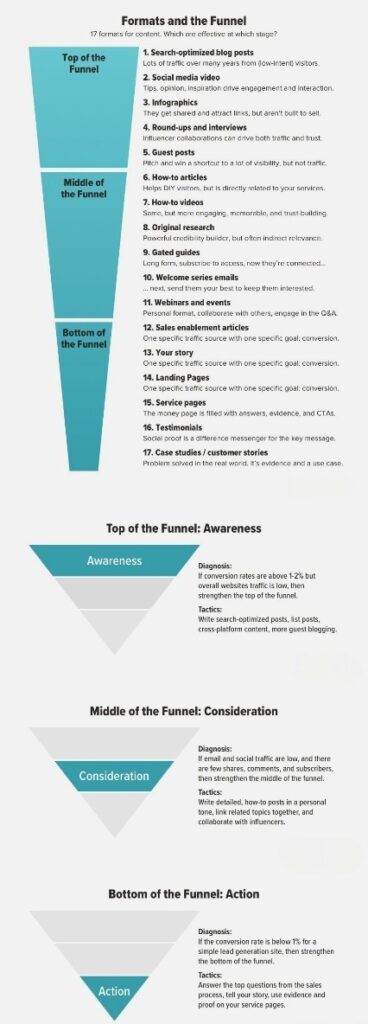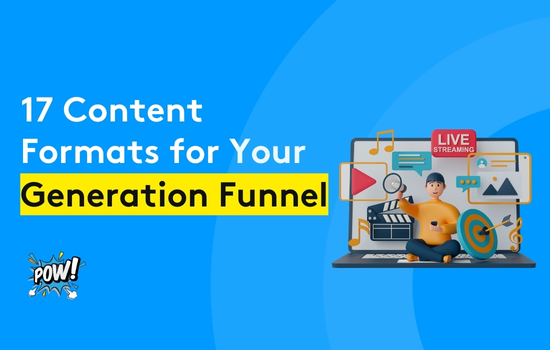In digital marketing, turning leads into loyal customers is a complex process called the lead generation funnel. This funnel guides potential customers through stages of awareness, consideration, and action.
Strategic content creation is key to moving prospects through these stages. Different content formats are useful at different stages of the funnel. In this guide, we’ll explore 17 content formats and where they fit in your lead generation funnel.
We share tips in this infographic, breaking things down as follows:
- Awareness
- Consideration
- Action

Top of the Funnel: Awareness
The top of the funnel is the first stage in the customer journey. Here, potential customers are starting to realise their needs or problems but don’t know about your brand yet.
The main goal at this stage is to get a wide audience to notice your brand. You do this by offering helpful information, insights, or entertainment that interests them.
By talking about their problems or interests, you start to show that your brand is trustworthy and begin building a relationship with these potential customers.
1. Blog Posts
Blog posts are essential for content marketing. They help address popular topics, solve common problems, and show your brand’s expertise. At the top of the funnel, informative blog posts attract potential leads and make them aware of their issues and possible solutions.
Here’s how to create effective blog posts:
- Find trending topics and common questions in your industry.
- Write informative, engaging, and well-researched posts on these topics.
- Use catchy headlines and visuals to draw attention.
- Include relevant keywords to boost search engine rankings.
- Share your posts on social media to reach a wider audience.
2. Social Media Videos
In today’s world of short attention spans, social media videos are great for grabbing attention and sparking curiosity. These short videos can show your brand’s personality, give quick tips, and preview upcoming content, boosting brand awareness.
Here’s how to make effective social media videos:
- Create short, attention-grabbing videos with quick value or insights.
- Keep videos concise and visually appealing, highlighting key points.
- Use platforms like TikTok, Instagram Reels, and YouTube Shorts for more exposure.
- Add captions and subtitles for accessibility.
- Encourage sharing and engagement to expand your video’s reach.
3. Infographics
Visuals can often explain complex information more effectively. Infographics turn valuable information into an easy-to-understand format, helping audiences quickly grasp key points. They are especially useful for showing statistics, trends, and data-driven insights.
Here’s how to create effective infographics:
- Simplify complex information into attractive infographics.
- Use colors, icons, and visuals to make the data easy to understand.
- Include your branding to reinforce brand recognition.
- Share infographics on social media and in blog posts.
- Offer options to download and share infographics for greater visibility.
4. Round-ups and Interviews
Gathering expert opinions and interviewing industry leaders boosts your brand’s credibility and draws a larger audience. These pieces engage readers and offer fresh perspectives to potential leads.
Here’s how to curate expert opinions and conduct interviews:
- Find experts or influencers in your industry for collaboration.
- Prepare thoughtful questions that encourage valuable insights.
- Compile the responses into a detailed blog post or video.
- Tag and mention the participants on social media to encourage sharing.
- Engage your audience by asking for their thoughts on the insights shared.
5. Guest Posts
Partnering with influencers or experts in your industry for guest posts can greatly expand your reach. This cross-promotion introduces your brand to new audiences and builds authority in your niche.
Here’s how to effectively collaborate on guest posts:
- Find reputable websites and blogs for guest posting.
- Pitch well-researched, valuable topic ideas to the hosts.
- Make sure your guest post matches the host’s audience and content style.
- Include a short author bio with a link to your website.
- Engage with the host’s audience by responding to comments.
Middle of the Funnel: Consideration
The middle of the funnel is where potential customers are actively considering their options to solve their needs or challenges. They understand their problems better and are looking for solutions that fit their requirements.
The main goal at this stage is to provide detailed information and resources to help potential customers evaluate their options. This includes showing how your products or services can solve their specific problems, offering insights, comparisons, and educational content to guide them toward making an informed decision.
The content and strategies here aim to nurture leads and position your brand as a valuable solution provider.
6. How-to Articles
As potential leads progress through the funnel, they crave detailed information. How-to articles provide step-by-step solutions to specific problems, showcasing your brand as a helpful resource and nurturing their decision-making process.
Here’s how to create effective how-to articles:
- Identify common challenges your audience encounters and provide practical solutions.
- Break down complicated processes into clear, step-by-step instructions.
- Use clear headings, bullet points, and visuals to enhance readability.
- Include personal experiences or case studies to add authenticity.
- Use calls-to-action (CTAs) to guide readers to related content or resources.
7. How-to Videos
Similar to how-to articles, how-to videos offer visual guidance and instruction, appealing to various learning styles and preferences to reach a wider audience.
Here’s how to create effective how-to videos:
- Select a specific topic or task to demonstrate in your video.
- Prepare a script or outline for a clear and organised presentation.
- Utilise engaging visuals, animations, and graphics to illustrate each step effectively.
- Optimise videos for different platforms and aspect ratios to maximise visibility.
- Encourage viewers to subscribe or visit your website for further details.
8. Original Research
Sharing original research, surveys, and studies demonstrates your brand’s dedication to innovation and industry knowledge, capturing the attention of leads interested in detailed insights and data.
Here’s how to create compelling research content:
- Choose a relevant and intriguing research topic in your industry.
- Design a survey or method to collect insightful data.
- Analyse the data and present your findings in a detailed report.
- Use visually appealing charts, graphs, and visuals to illustrate your data.
- Share your research findings on your website, social media, and through email newsletters.
9. Gated Guides
During this stage, leads are ready to share their contact details in exchange for valuable resources. Gated guides like eBooks or detailed whitepapers provide substantial information and act as lead magnets to capture contact information.
Here’s how to create effective gated guides:
- Select a comprehensive and valuable topic for your guide.
- Develop high-quality content that offers deep insights.
- Design a compelling landing page that highlights the guide’s benefits.
- Set up a form to collect lead information in exchange for access to the guide.
- Promote the guide through targeted social media ads and email campaigns.
10. Welcome Series Emails
Once leads share their contact information, you can start a welcome email series. These emails introduce your brand, showcase your top content, and build a personal connection with the prospect.
Here’s how to create an effective welcome email series:
- Develop a sequence of automated emails that introduce your brand’s story and values.
- Share your most popular blog posts, videos, and resources that provide value to the recipient.
- Personalise the emails based on the lead’s interests and actions, using information you’ve gathered.
- Include a clear call-to-action (CTA) in each email to encourage recipients to take the next step.
- Monitor engagement metrics like open rates and click-through rates to adjust the series based on recipient behavior.
11. Webinars and Events
Interactive webinars and online events are powerful tools to engage directly with your audience, facilitating in-depth discussions, live demonstrations, and Q&A sessions that build community and trust.
Here’s how to organise a successful webinar or online event:
- Select a relevant and engaging topic that interests your audience.
- Plan and design a visually appealing presentation to keep attendees engaged.
- Promote the event through social media, email marketing, and your website to attract participants.
- Interact with attendees during the event through Q&A sessions and live chats to foster engagement.
- Follow up with attendees afterward by providing additional resources and special offers to maintain interest and build relationships.
Bottom of the Funnel: Action
The bottom of the funnel is the last stage in lead generation, where potential customers have moved through awareness and consideration and are now ready to take action. This action might involve making a purchase, signing up for a service, or engaging with your brand in a meaningful way.
The main goal at the bottom-of-the-funnel stage is to encourage and facilitate this action. Strategies and content here focus on providing the final information, incentives, and assurances that potential customers need to convert into actual customers.
This includes sharing pricing details, case studies, testimonials, and strong calls to action that guide them to make a decision and complete the desired action.
12. Sales Enablement Articles
As leads near the decision-making stage, they look for content that tackles their specific challenges and shows how your product or service can help. Sales enablement articles are designed to address these concerns directly and demonstrate the value of your offering.
Here’s how to create effective sales enablement articles:
- Identify common objections or concerns potential customers often have.
- Develop articles that directly tackle these objections and offer solutions.
- Highlight customer testimonials and case studies to validate your solutions.
- Include a clear call-to-action (CTA) that encourages readers to request a demo or consultation.
- Optimise your articles for search engines to attract prospects actively searching for solutions.
13. Your Story
Sharing your brand’s story can forge an emotional bond with potential customers. By showcasing your journey, mission, and values, you humanise your brand, making it more relatable and influencing their decision-making process.
Here’s how to effectively share your brand story:
- Craft a compelling and authentic brand narrative that resonates with your audience.
- Highlight key milestones, challenges, and values that reflect your brand’s journey.
- Incorporate your brand story into your website’s “About Us” page and marketing materials.
- Use storytelling techniques in your social media posts and videos to engage your audience.
- Connect your brand story to your products or services to demonstrate their relevance and value.
14. Landing Pages
Dedicated landing pages play a crucial role in turning leads into customers. They offer focused information about a particular product or service and feature a clear call to action (CTA) to encourage leads to make a purchase.
Here are key tips for designing effective landing pages:
- Design with a clean layout and clear organisation.
- Craft compelling headlines and subheadings that emphasise benefits.
- Use engaging visuals that enhance the content.
- Write persuasive copy that clearly explains the value of your offer.
- Create a prominent CTA that prompts action and stands out on the page.
15. Service Pages
Service pages on your website play a vital role in informing potential customers about your offerings and guiding them towards a purchasing decision.
Here’s how to create effective service pages:
- Organise the information on your service pages logically, making it easy for visitors to navigate.
- Highlight the key features, benefits, and unique selling points of your services to showcase their value.
- Use visuals like images or videos to demonstrate your services in action and enhance understanding.
- If applicable, provide clear pricing information or options to give transparency to potential customers.
- Include a clear call-to-action (CTA) that encourages visitors to contact you or request a quote, guiding them towards taking the next step.
16. Testimonials
Customer testimonials are powerful tools that can greatly influence purchasing decisions by providing social proof. Here’s how to effectively use them:
- Reach out to satisfied customers: Ask customers who have had positive experiences with your product or service to provide testimonials.
- Include specific details: Highlight specific aspects of the customer’s experience and the results they achieved. Concrete details make testimonials more credible and compelling.
- Showcase diversity: Feature testimonials from a variety of customer types and use cases to demonstrate broad satisfaction and applicability.
- Strategic placement: Place testimonials strategically throughout your website, particularly on relevant product or service pages, to reinforce their impact.
- Consider video testimonials: Video testimonials can enhance authenticity and engagement. Consider incorporating them alongside written testimonials for added impact.
By leveraging customer testimonials effectively, you can build trust & persuade potential customers to choose your products or services.
17. Case Studies
Case studies are detailed stories that illustrate how your products or services have successfully solved specific problems for your customers. They serve as compelling evidence of your offerings’ effectiveness and benefits.
Here’s how to create impactful case studies:
- Select compelling customer success stories: Choose stories that potential customers can relate to and find compelling.
- Outline the challenge, solution, and results: Clearly describe the customer’s initial challenge, how your product or service provided a solution, and the measurable results achieved.
- Use a storytelling approach: Engage readers with a narrative format that flows logically from problem to solution to outcome.
- Incorporate visuals: Include visuals such as before-and-after images, charts, and graphs to visually represent the impact and results.
- Highlight uniqueness: Showcase the unique aspects of each case study to demonstrate your expertise and versatility in addressing various challenges.
By crafting well-rounded case studies, you can effectively showcase your offerings’ benefits & build trust with customers looking for real-world proof of your capabilities.
Final Words
The lead generation funnel is a dynamic journey that relies on various content formats to guide potential customers through stages like awareness, consideration, and action.
By strategically using the right content at each stage, you can capture your audience’s attention, nurture their interest, and encourage them to take action.
Whether you’re using blog posts to introduce your brand, gated guides to capture leads, or case studies to finalise decisions, each content type plays a crucial role in a strong lead generation strategy.
The key is understanding your audience’s needs, tailoring your content to meet those needs, and ensuring a smooth transition from awareness to conversion.




